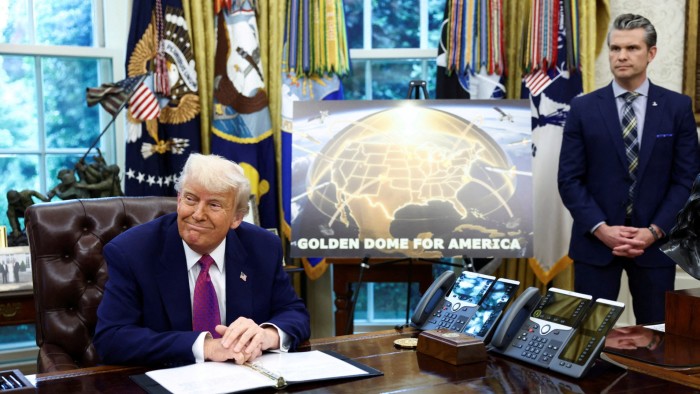Unlock the White House Watch newsletter for free
Your guide to what Trump’s second term means for Washington, business and the world
Donald Trump has said it would cost Canada $61bn to be part of his ambitious “Golden Dome” missile defence shield, but that it would be free if Ottawa gave up its sovereignty to become the 51st US state.
“I told Canada, which very much wants to be part of our fabulous Golden Dome System, that it will cost $61 Billion Dollars if they remain a separate, but unequal, Nation, but will cost ZERO DOLLARS if they become our cherished 51st State,” the US president wrote on his Truth Social platform on Tuesday. “They are considering the offer!”
A spokesperson for Canada’s Prime Minister Mark Carney said: “The prime minister has been clear at every opportunity, including in his conversations with president Trump, that Canada is an independent, sovereign nation, and it will remain one.”
The US and Canada already have a defence agreement, the North American Aerospace Defense Command (Norad), which includes ballistic missile attack detection. Canada’s responsibilities in Norad have come under the spotlight as the Arctic Circle emerges as the new frontline in a geopolitical contest with Russia and China.
The spokesperson for Carney added that the prime minister was “having wide-ranging and constructive discussions” with American counterparts, that “include strengthening Norad and related initiatives such as the Golden Dome”.
Carney told reporters last week that his country’s participation in the Golden Dome “has been discussed at a high level” though he would not “put a price tag” on its involvement. “I’m not sure one negotiates on this,” he added.
“We are conscious that we have an ability, if we so choose, to complete the Golden Dome with investments and partnership.”
It is likely Canada would need to be involved in Golden Dome in some way, considering that an intercontinental ballistic missile fired from Russia — one of the threats the shield would be designed to intercept — would fly over northern Canada to reach the US.
“It seems like a negotiating tactic, there is no way Canada is going to fork over $61bn,” said Richard Shimooka, a defence expert and senior fellow at The Macdonald-Laurier Institute, an Ottawa-based think-tank.
“The idea is extremely technically risky, it’s inexact in details too. There’s huge risks involved in this, this system is akin to a moonshot with very shaky political and financial support within the US,” he said.
Trump last week claimed the project would cost $175bn, vowing to make it “operational” by the end of his presidential term. Using interceptors in space, the shield would protect against sophisticated threats such as hypersonic missiles, advanced cruise missiles and intercontinental ballistic missiles launched by US adversaries.
However, the envisioned web of space-based interceptors requires technology that does not exist, meaning the Golden Dome faces considerable development hurdles. The non-partisan Congressional Budget Office also estimated that developing and launching space-based interceptors could cost up to $542bn over 20 years.
Earlier on Tuesday King Charles opened Canada’s parliament as a sign of support for the country’s “freedom” at a time of heightened tensions with Trump and the US. In his second term, the president has repeatedly pushed to make Canada part of the US.
King Charles’s speech outlined Canada’s increased defence spending while the “world faces unprecedented challenges, generating uncertainties across the continents with regards to peace and stability”.
In March, Canada struck a C$6bn ($4.2bn) deal with Australia to develop a state-of-the-art Arctic radar system that would provide early warning coverage from the US-Canada border up to the Arctic.
“A key component of Canada’s Norad modernisation plan, the radar system’s long-range surveillance and threat tracking capabilities will detect and deter threats across the North,” Carney said when announcing the deal.


